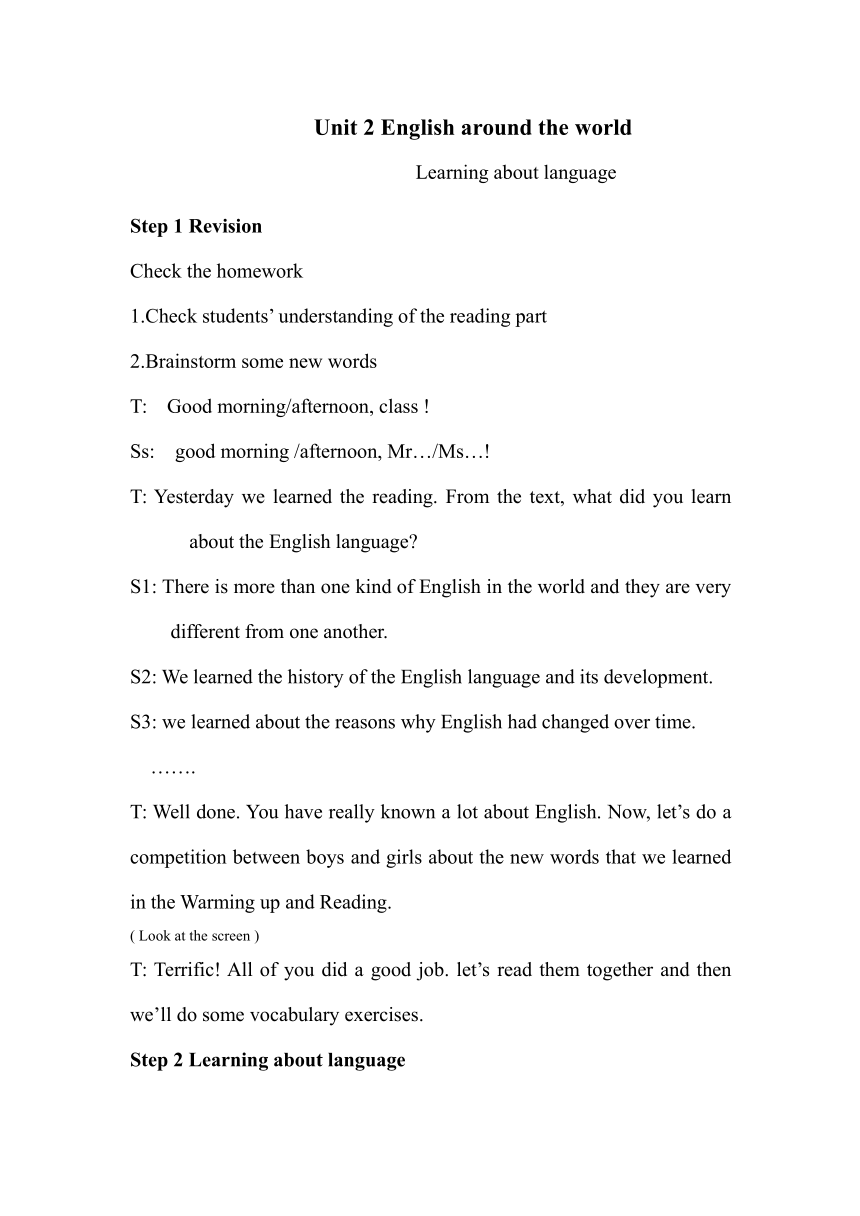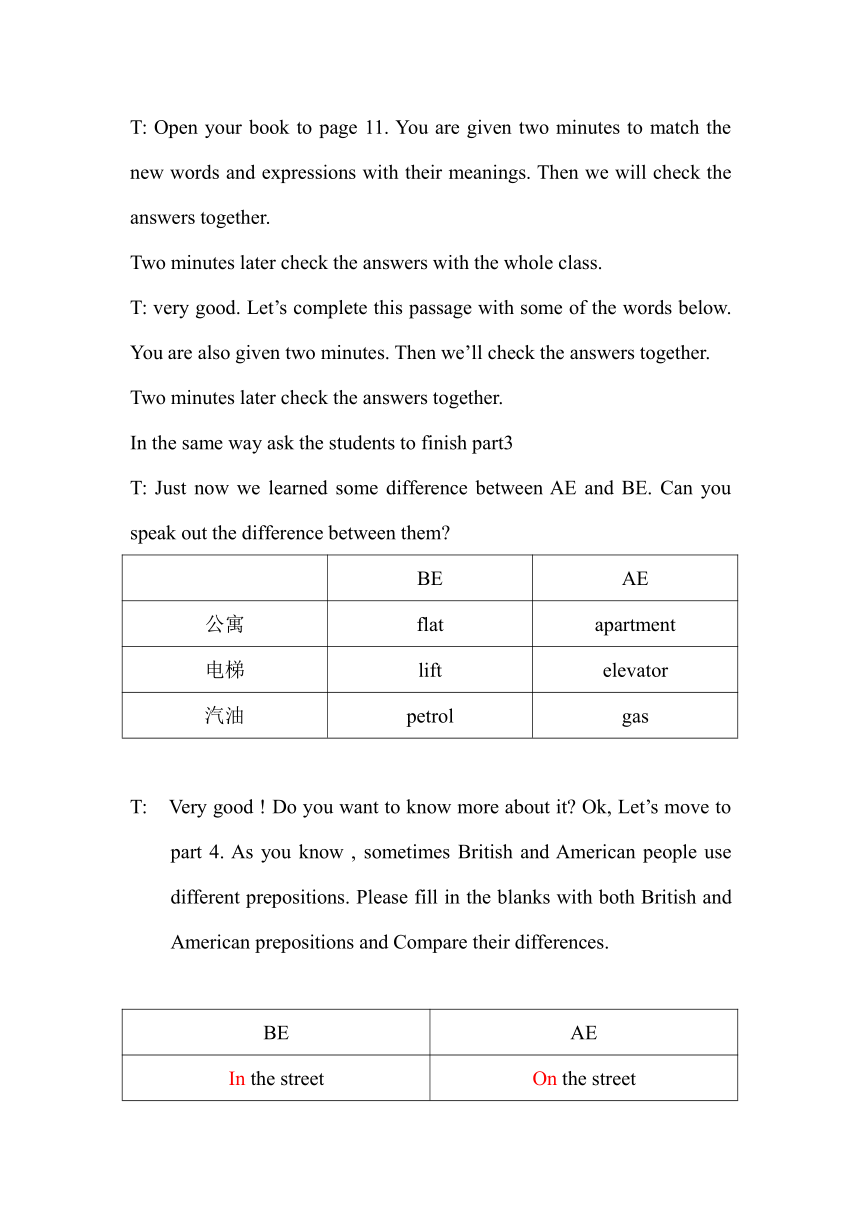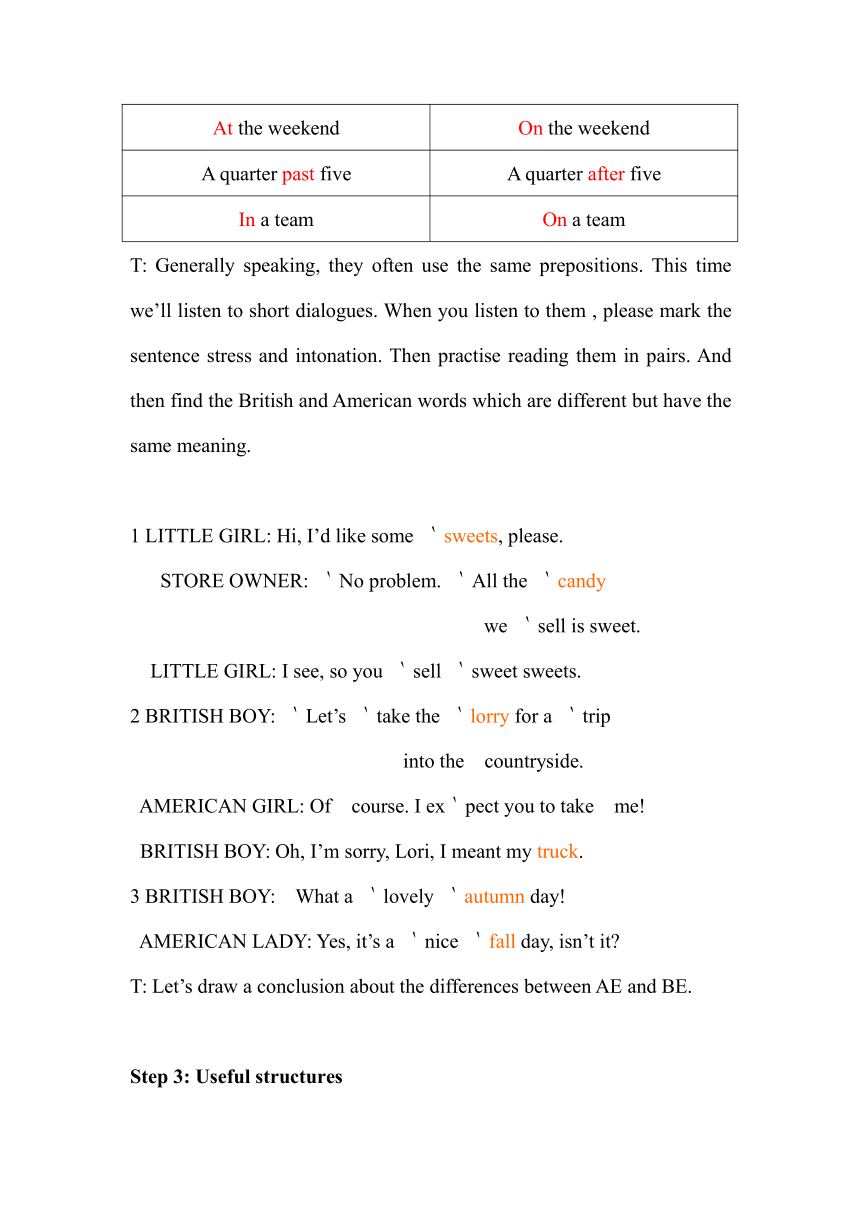普通高中课程标准实验教科书NSEFC必修(1) Unit2English around the World (Using Language)教案[上学期]
文档属性
| 名称 | 普通高中课程标准实验教科书NSEFC必修(1) Unit2English around the World (Using Language)教案[上学期] |  | |
| 格式 | rar | ||
| 文件大小 | 9.1KB | ||
| 资源类型 | 教案 | ||
| 版本资源 | 人教版(新课程标准) | ||
| 科目 | 英语 | ||
| 更新时间 | 2006-08-22 17:40:00 | ||
图片预览



文档简介
Unit 2 English around the world
Learning about language
Step 1 Revision
Check the homework
1.Check students’ understanding of the reading part
2.Brainstorm some new words
T: Good morning/afternoon, class !
Ss: good morning /afternoon, Mr…/Ms…!
T: Yesterday we learned the reading. From the text, what did you learn about the English language
S1: There is more than one kind of English in the world and they are very different from one another.
S2: We learned the history of the English language and its development.
S3: we learned about the reasons why English had changed over time.
…….
T: Well done. You have really known a lot about English. Now, let’s do a competition between boys and girls about the new words that we learned in the Warming up and Reading.
( Look at the screen )
T: Terrific! All of you did a good job. let’s read them together and then we’ll do some vocabulary exercises.
Step 2 Learning about language
T: Open your book to page 11. You are given two minutes to match the new words and expressions with their meanings. Then we will check the answers together.
Two minutes later check the answers with the whole class.
T: very good. Let’s complete this passage with some of the words below. You are also given two minutes. Then we’ll check the answers together.
Two minutes later check the answers together.
In the same way ask the students to finish part3
T: Just now we learned some difference between AE and BE. Can you speak out the difference between them
BE AE
公寓 flat apartment
电梯 lift elevator
汽油 petrol gas
T: Very good ! Do you want to know more about it Ok, Let’s move to part 4. As you know , sometimes British and American people use different prepositions. Please fill in the blanks with both British and American prepositions and Compare their differences.
BE AE
In the street On the street
At the weekend On the weekend
A quarter past five A quarter after five
In a team On a team
T: Generally speaking, they often use the same prepositions. This time we’ll listen to short dialogues. When you listen to them , please mark the sentence stress and intonation. Then practise reading them in pairs. And then find the British and American words which are different but have the same meaning.
1 LITTLE GIRL: Hi, I’d like some ‵sweets, please.
STORE OWNER: ‵No problem. ‵All the ‵candy
we ‵sell is sweet.
LITTLE GIRL: I see, so you ‵sell ‵sweet sweets.
2 BRITISH BOY: ‵Let’s ‵take the ‵lorry for a ‵trip
into the countryside.
AMERICAN GIRL: Of course. I ex‵pect you to take me!
BRITISH BOY: Oh, I’m sorry, Lori, I meant my truck.
3 BRITISH BOY: What a ‵lovely ‵autumn day!
AMERICAN LADY: Yes, it’s a ‵nice ‵fall day, isn’t it
T: Let’s draw a conclusion about the differences between AE and BE.
Step 3: Useful structures
T: Let’s look at the screen . Both Bush and Blair want you to help them to take the dog for a walk.
T: Would you like to help Bush Why Why not
S4: No. Of course not. Because he is very rude. ( He is not polite.)
T: Good. Because Bush gives a command .He orders you to help him. Would you like to help Blair Why
S5: I would like to help him, because he is very polite.
T: Good. Blair gives a request. He asks you to help him.
T: If you need help, should you make a request or should you give a commands
S6: I think we should make a request It’s a polite way to ask for help..
T: very good. In English , giving commands is less polite than making a request. Not everyone should give commands. People who often give commands are bosses, teachers and parents. There are more and less polite ways to give commands.
T: Now In pairs look at the commands on the screen. Then look at the different expressions for making requests. One student gives the command and the other changes it into a request.
Two minutes later check the answers together.
T: Here are three situations. Please make some dialogues with your partner using the commands /requests above.
Situatio1.
you need to ask someone to close the door but you cannot do it yourself. There are many people in the room but you cannot tell who are important and who are not. So how do you do it politely
Situation2
You are standing in the middle of a train carriage and you need to leave. You must not push your way to the door , so how do you do it politely
Situation 3
Situation3
A bear is about to approach a boy. What do you say to him to make sure that he won’t be hurt
Five minutes later ask some students to come to the front to make the short dialogues.
T: You really did a very good job. Let’s see how to retell the commands and requests in indirect speech.
Step 4 Indirect speech
Commands:
Bush said to the boy
Take the dog for a walk!
Get me something to drink!
Clean your room!
Don’t play with fire
Bush told the boy to take the dog for a walk.
=>tell sb. (not) to do
Requests:
Blair said to the boy:
Please…
Could you please…
Would you please…
Blair asked the boy to take the dog for a walk.
=> ask sb. (not) to do
Activity
In groups of three, think of some commands and requests. One is to give the first command or request. Ask another person in your group to tell somebody what you said. The third person will change the requests or commands into indirect speech. Then change the roles.
Example: s1 (as a teacher): Please don’t talk in class
S2: What did our teacher tell/ask us
S3: She told /asked not to talk in class.
Homework
Finish the exercise on page 49-50
Learning about language
Step 1 Revision
Check the homework
1.Check students’ understanding of the reading part
2.Brainstorm some new words
T: Good morning/afternoon, class !
Ss: good morning /afternoon, Mr…/Ms…!
T: Yesterday we learned the reading. From the text, what did you learn about the English language
S1: There is more than one kind of English in the world and they are very different from one another.
S2: We learned the history of the English language and its development.
S3: we learned about the reasons why English had changed over time.
…….
T: Well done. You have really known a lot about English. Now, let’s do a competition between boys and girls about the new words that we learned in the Warming up and Reading.
( Look at the screen )
T: Terrific! All of you did a good job. let’s read them together and then we’ll do some vocabulary exercises.
Step 2 Learning about language
T: Open your book to page 11. You are given two minutes to match the new words and expressions with their meanings. Then we will check the answers together.
Two minutes later check the answers with the whole class.
T: very good. Let’s complete this passage with some of the words below. You are also given two minutes. Then we’ll check the answers together.
Two minutes later check the answers together.
In the same way ask the students to finish part3
T: Just now we learned some difference between AE and BE. Can you speak out the difference between them
BE AE
公寓 flat apartment
电梯 lift elevator
汽油 petrol gas
T: Very good ! Do you want to know more about it Ok, Let’s move to part 4. As you know , sometimes British and American people use different prepositions. Please fill in the blanks with both British and American prepositions and Compare their differences.
BE AE
In the street On the street
At the weekend On the weekend
A quarter past five A quarter after five
In a team On a team
T: Generally speaking, they often use the same prepositions. This time we’ll listen to short dialogues. When you listen to them , please mark the sentence stress and intonation. Then practise reading them in pairs. And then find the British and American words which are different but have the same meaning.
1 LITTLE GIRL: Hi, I’d like some ‵sweets, please.
STORE OWNER: ‵No problem. ‵All the ‵candy
we ‵sell is sweet.
LITTLE GIRL: I see, so you ‵sell ‵sweet sweets.
2 BRITISH BOY: ‵Let’s ‵take the ‵lorry for a ‵trip
into the countryside.
AMERICAN GIRL: Of course. I ex‵pect you to take me!
BRITISH BOY: Oh, I’m sorry, Lori, I meant my truck.
3 BRITISH BOY: What a ‵lovely ‵autumn day!
AMERICAN LADY: Yes, it’s a ‵nice ‵fall day, isn’t it
T: Let’s draw a conclusion about the differences between AE and BE.
Step 3: Useful structures
T: Let’s look at the screen . Both Bush and Blair want you to help them to take the dog for a walk.
T: Would you like to help Bush Why Why not
S4: No. Of course not. Because he is very rude. ( He is not polite.)
T: Good. Because Bush gives a command .He orders you to help him. Would you like to help Blair Why
S5: I would like to help him, because he is very polite.
T: Good. Blair gives a request. He asks you to help him.
T: If you need help, should you make a request or should you give a commands
S6: I think we should make a request It’s a polite way to ask for help..
T: very good. In English , giving commands is less polite than making a request. Not everyone should give commands. People who often give commands are bosses, teachers and parents. There are more and less polite ways to give commands.
T: Now In pairs look at the commands on the screen. Then look at the different expressions for making requests. One student gives the command and the other changes it into a request.
Two minutes later check the answers together.
T: Here are three situations. Please make some dialogues with your partner using the commands /requests above.
Situatio1.
you need to ask someone to close the door but you cannot do it yourself. There are many people in the room but you cannot tell who are important and who are not. So how do you do it politely
Situation2
You are standing in the middle of a train carriage and you need to leave. You must not push your way to the door , so how do you do it politely
Situation 3
Situation3
A bear is about to approach a boy. What do you say to him to make sure that he won’t be hurt
Five minutes later ask some students to come to the front to make the short dialogues.
T: You really did a very good job. Let’s see how to retell the commands and requests in indirect speech.
Step 4 Indirect speech
Commands:
Bush said to the boy
Take the dog for a walk!
Get me something to drink!
Clean your room!
Don’t play with fire
Bush told the boy to take the dog for a walk.
=>tell sb. (not) to do
Requests:
Blair said to the boy:
Please…
Could you please…
Would you please…
Blair asked the boy to take the dog for a walk.
=> ask sb. (not) to do
Activity
In groups of three, think of some commands and requests. One is to give the first command or request. Ask another person in your group to tell somebody what you said. The third person will change the requests or commands into indirect speech. Then change the roles.
Example: s1 (as a teacher): Please don’t talk in class
S2: What did our teacher tell/ask us
S3: She told /asked not to talk in class.
Homework
Finish the exercise on page 49-50
